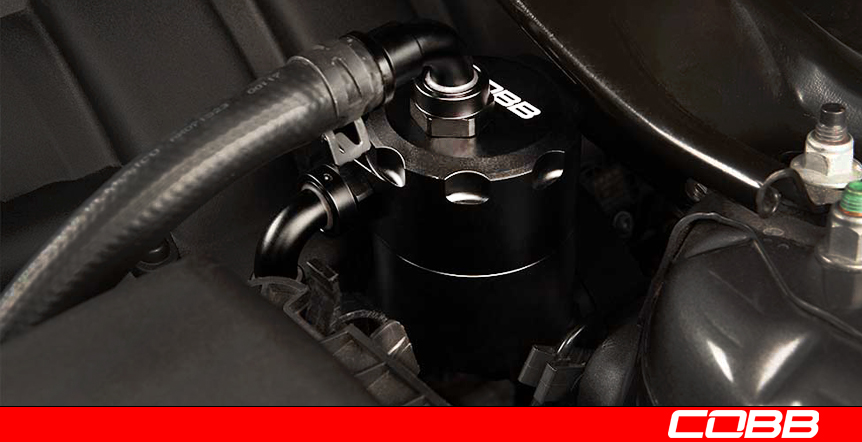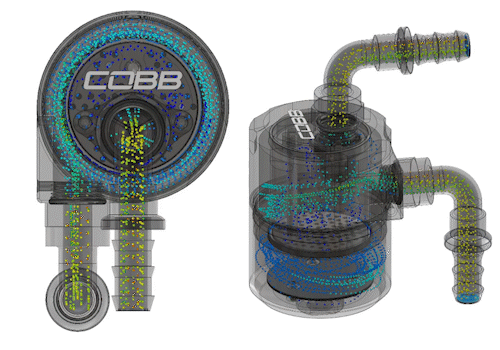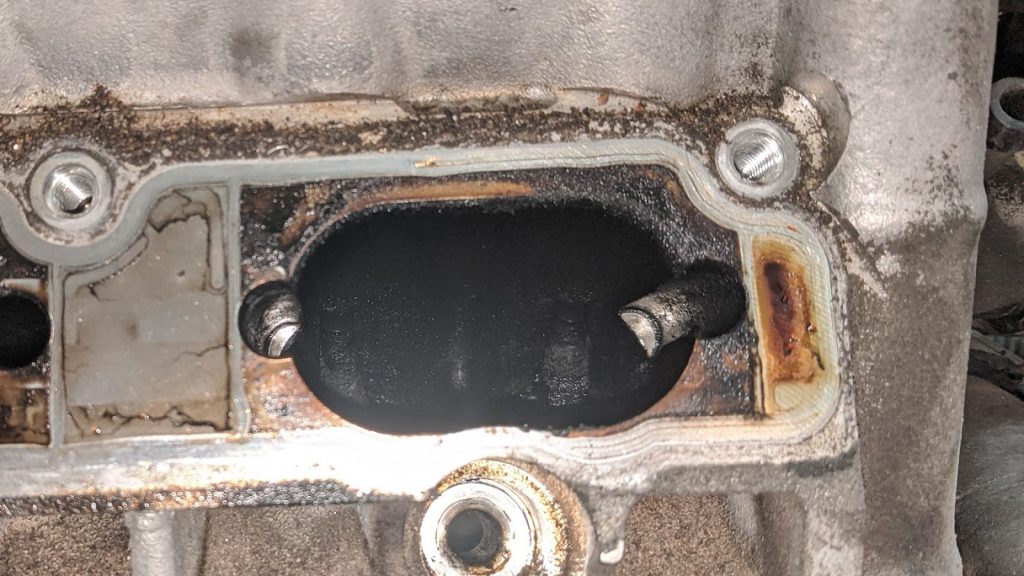Air/Oil Separators for Ford Ecoboost Vehicles Now Available!

Today, we are releasing a brand new product, the COBB Air/Oil Separator for the Focus ST, Focus RS, and Mustang Ecoboost vehicles! These separator cans and fittings are 6061 aluminum anodized black for that clean engine bay look and to match the other COBB parts you have in the engine bay. One thing you may notice as that we are also sandwiching between the factory baffle plate on the engine with our COBB unit which introduces some extra baffling to the oil flow. But it doesn’t stop there, the can contains a custom swirlpot design element that provides additional baffling to the system.
Ford’s EcoBoost engine doesn’t have a great spot to tap in, so we went with the route of incorporating the factory breather plate with a spacer plate that we created from 33% glass-filled nylon and is injection molded for perfect fitment. The COBB oil drain plate is sandwiched between the OEM air oil separator and engine block. It uses an additional COBB provided OEM gasket to maintain a leak-free interface with the engine block.
The COBB Air/Oil Separator system installs in series with the original PCV circuit, forcing air from the crankcase through a swirl pot and series of baffles that promote heavier oil particles in the blowby vapor to condense and collect as a liquid at the base of the canister. A drain line returns this condensed liquid oil to the crankcase. This kit utilizes a drain-back system keeps valves cleaner and reduces chances of detonation by removing oil particles from the PCV gasses going to the intake manifold. This equates to a cleaner and stronger engine that can push more power with less maintenance or risk.

In an internal combustion engine, there’s a small amount of blow-by that occurs during the combustion process. This blow-by consists of combustion gases, unburned fuel, and oil vapors that escape past the piston rings and enter the crankcase. Most engines have a Positive Crankcase Ventilation system, which routes these blow-by gases back into the intake manifold. This system helps reduce emissions and prevent pressure buildup in the crankcase. However, it also means that oil vapors can be carried into the intake system, leading to a phenomenon known as “oil vapor ingestion.” In a turbocharged engine, the oil vapor ingestion issue is amplified. The turbocharger compresses the incoming air before it enters the combustion chamber, and if oil vapor is present in this compressed air, it can lead to deposits on the compressor blades, reduced efficiency, and potentially even engine knock.
Here’s a look at some dirty valves on one our employee’s Mk6 GTI:

An air/oil separator is installed in the PCV system between the crankcase and the intake manifold. It’s essentially a container with baffles or mesh screens that allow the blow-by gases to enter but capture the oil vapor. The captured oil then drains back into the engine’s oil pan, while the cleaned gases continue to the intake manifold. This prevents the oil from reaching the intake system and turbocharger. With a catch can, you’ll need to occasionally check it and empty it before it gets full and overflows. With this, you can track the car, daily the car, or hard park the car without any worry!
Overall, an air/oil separator is a useful aftermarket addition to turbocharged cars, especially for enthusiasts who want to maintain the longevity and performance of their engines. It helps address the challenges posed by oil vapor ingestion and blow-by gases in these high-performance setups. Unleash the complete potential of your Mustang’s engine by exploring our range of tuning and aftermarket Mustang performance parts. Maximize your Mustang’s performance with COBB.



Have a 2020 Edge ST. Will the product work on it? Thanks
When will this be available for the F150 platforms?
Will there be issues with lines freezing in the winter? I live in Canada where is can get very cold and I am worried about freezing issues.
Hey Christian, We did some extensive testing over winter which included a pretty decent freeze for us down here in Texas and saw no issues with gunk build-up in the can. In practice, letting the car warm up as you would normally should mitigate those concerns. The location of the can in the engine bay allows it to warm up very quickly.
Marshall@COBB